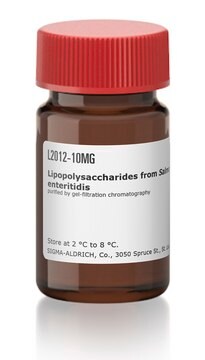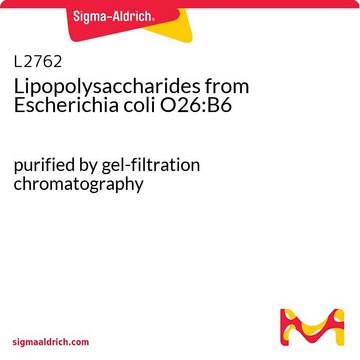L4774
Lipopolysaccharides from Salmonella enterica serotype enteritidis
purified by ion-exchange chromatography
Synonym(s):
LPS
Sign Into View Organizational & Contract Pricing
All Photos(1)
About This Item
Recommended Products
biological source
Salmonella enterica (Serotype enteritidis)
Quality Level
form
lyophilized powder
purified by
ion-exchange chromatography
impurities
<1% Protein
<1% RNA
shipped in
ambient
storage temp.
2-8°C
Looking for similar products? Visit Product Comparison Guide
General description
This product is extracted from Salmonella enteritidis and purified by ion exchange. The source strain is ATCC 13076. Lipopolysaccharide from Salmonella enteritidis is mutagenic in murine spleen cells and causes a plaque-forming response in those cells.
Application
Lipopolysaccharides (LPSs) are characteristic components of the cell wall of Gram-negative bacteria. LPS and its lipid A moiety stimulate cells of the innate immune system by the Toll-like receptor 4 (TLR4).
Biochem/physiol Actions
Lipopolysaccharides (LPS) are localized in the outer layer of the membrane and are, in noncapsulated strains, exposed on the cell surface. They contribute to the integrity of the outer membrane, and protect the cell against the action of bile salts and lipophilic antibiotics.
Preparation Note
The product is soluble in water (5 mg/ml) or cell culture medium (1 mg/ml) yielding a hazy, faint yellow solution. A more concentrated, though still hazy, solution (20 mg/ml) has been achieved in aqueous saline after vortexing and warming to 70-80 oC. Lipopolysaccharides are molecules that form micelles in every solvent. Hazy solutions are observed in water and phosphate buffered saline. Organic solvents do not give clearer solutions. Methanol yields a turbid suspension with floaters, while water yields a homogeneously hazy solution.
Other Notes
To gain a comprehensive understanding of our extensive range of Lipopolysaccharides for your research, we encourage you to visit our Carbohydrates Category page.
related product
Product No.
Description
Pricing
Storage Class Code
11 - Combustible Solids
WGK
WGK 3
Flash Point(F)
Not applicable
Flash Point(C)
Not applicable
Personal Protective Equipment
dust mask type N95 (US), Eyeshields, Gloves
Choose from one of the most recent versions:
Already Own This Product?
Find documentation for the products that you have recently purchased in the Document Library.
Customers Also Viewed
Yelena Y Grinberg et al.
PloS one, 6(4), e19294-e19294 (2011-05-05)
Spreading depression (SD) is thought to cause migraine aura, and perhaps migraine, and includes a transient loss of synaptic activity preceded and followed by increased neuronal excitability. Activated microglia influence neuronal activity and play an important role in homeostatic synaptic
Basilia Zingarelli et al.
Immunology, 124(1), 51-57 (2007-11-22)
Peroxisome proliferator activated receptor-gamma (PPARgamma) has been reported to exert anti-inflammatory properties in endotoxic shock and sepsis. One phenomenon that alters the inflammatory response to endotoxin [lipopolysaccharide (LPS)] is endotoxin tolerance, which is caused by previous exposure to endotoxin. Here
A Zarbock et al.
British journal of pharmacology, 155(3), 357-364 (2008-07-01)
Acute lung injury (ALI) remains a major challenge in critical care medicine. Both neutrophils and chemokines have been proposed as key components in the development of ALI. The main chemokine receptor on neutrophils is CXCR2, which regulates neutrophil recruitment and
Jörg Reutershan et al.
European journal of immunology, 39(6), 1597-1607 (2009-06-06)
The Duffy antigen receptor for chemokines (DARC) has a high affinity for CC and CXC chemokines. However, it lacks the ability to induce cell responses that are typical for classical chemokine receptors. The role of DARC in inflammatory conditions remains
Guangming Ren et al.
The EMBO journal, 38(6) (2019-02-23)
Deubiquitination of NLRP3 has been suggested to contribute to inflammasome activation, but the roles and molecular mechanisms are still unclear. We here demonstrate that ABRO1, a subunit of the BRISC deubiquitinase complex, is necessary for optimal NLRP3-ASC complex formation, ASC
Our team of scientists has experience in all areas of research including Life Science, Material Science, Chemical Synthesis, Chromatography, Analytical and many others.
Contact Technical Service


